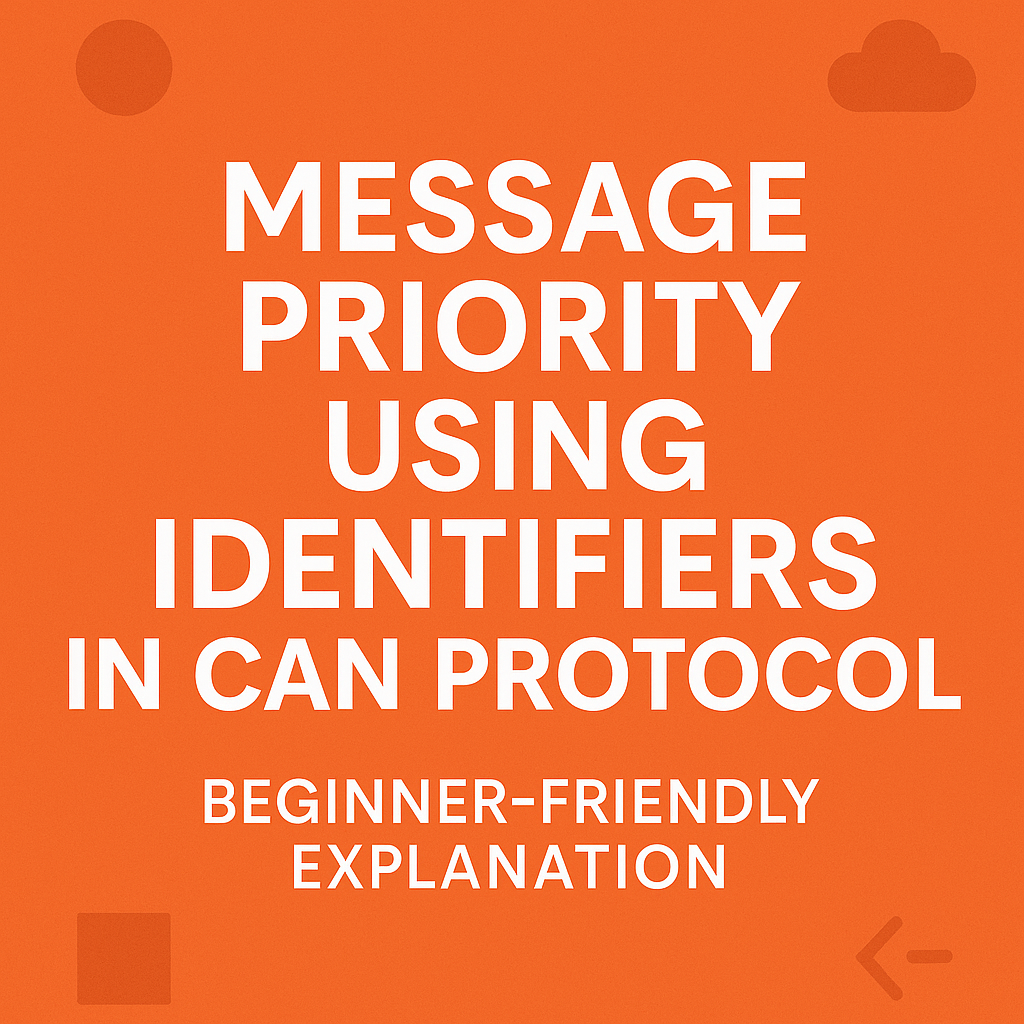Learn how message priority using identifiers in CAN protocol. This beginner-friendly guide explains message arbitration, why lower IDs have higher priority, and how real-time communication is managed in embedded systems.
Master Message Priority Using Identifiers in CAN Protocol
In communication systems, especially in embedded systems and real-time data networks like CAN (Controller Area Network), every message has something called an identifier. But why is this identifier important?
A very common interview and exam question is:
As the message carries the identifier, _______ is decided?
- Parity
- Stop Bit
- Priority ✅
- Constant
The correct answer is: Priority
Let’s break this down in a beginner-friendly way.
What is a Message Identifier?
In many communication protocols like CAN, each message that is transmitted carries a unique identifier. Think of it like a label or tag that tells:
- What kind of data it is
- Who is sending the message
- How urgent or important the message is
Why is Priority Decided by the Identifier?
In systems like CAN, multiple devices (nodes) can try to send messages at the same time. But we can’t have all of them talk together — it would create a mess!
Instead of sending them randomly, the identifier in the message is used to assign priority. Here’s how:
- The lower the identifier number, the higher the priority
- During transmission, if two messages compete, the one with the lowest identifier (highest priority) wins
Real-Life Analogy
Imagine you’re in a classroom, and everyone raises their hand to speak. The teacher says:
“Whoever has the lowest roll number gets to speak first.”
This is exactly how priority is decided using identifiers in communication protocols.
Examples in Embedded Systems
- In a car, the braking system message will have a higher priority than the music player message.
- So, even if both try to send messages together, the brake message wins, because it has a higher priority identifier.
What About the Other Options?
Let’s understand why they’re incorrect:
- Parity:
- Used for error checking, not for deciding priority.
- It just helps detect if a bit has flipped during transmission.
- Stop Bit:
- Used in serial communication to mark the end of a data packet.
- It doesn’t influence message importance.
- Constant:
- This is too vague.
- Message identifiers can change depending on the system design and are not necessarily constant.
Summary Table of Message Priority Using Identifiers in CAN Protocol
| Term | Role in Communication | Priority Related? |
|---|---|---|
| Identifier | Determines priority & identity | ✅ Yes |
| Parity | Error detection mechanism | ❌ No |
| Stop Bit | Signals end of message | ❌ No |
| Constant | Irrelevant in this context | ❌ No |
Final Answer
As the message carries the identifier, Priority is decided
In CAN Bus, this system is called bitwise arbitration. When two nodes send a message at the same time, the dominant bits (0) override recessive bits (1). That’s how the one with the lowest ID wins transmission!
FAQ – Message Priority Using Identifiers in CAN Protocol
Q1. What is message priority in CAN protocol?
Answer:
In the CAN protocol, message priority determines which message is allowed to transmit first when multiple devices try to send messages simultaneously. The message with the lowest identifier (ID) is given the highest priority.
Q2. How does the identifier affect priority in CAN?
Answer:
In CAN, each message has a unique identifier. During transmission, the CAN bus uses bitwise arbitration to compare identifiers. The message with more dominant bits (0) wins, meaning a lower numerical ID has higher priority.
Q3. Why is priority important in embedded systems?
Answer:
Priority ensures that critical messages (like braking commands in vehicles) are transmitted before less important ones (like infotainment data), improving safety and performance in real-time systems.
Q4. Is message priority in CAN fixed or changeable?
Answer:
The priority is based on the identifier value, which is usually defined at design time. However, in some systems, identifiers can be reassigned to change message priority dynamically.
Q5. What happens when two CAN nodes transmit at the same time?
Answer:
The CAN protocol uses arbitration. Both messages are sent bit-by-bit, and if a node sends a recessive bit (1) but detects a dominant bit (0), it stops transmitting. The message with the lower ID wins arbitration and continues transmission.
Q6. What’s the difference between message identifier and message content?
Answer:
The identifier determines the priority and type of message, while the content (data field) carries the actual information being sent. The identifier doesn’t describe the data itself, but how urgently it needs to be transmitted.
Q7. Does CAN use any error checking while determining priority?
Answer:
No, error checking (like CRC, parity) happens after arbitration. Priority is determined solely by comparing identifiers, not by any form of error detection.
Q8. Can two messages have the same identifier?
Answer:
In well-designed systems, each identifier should be unique to avoid conflicts. However, if two messages have the same ID and try to transmit together, it may lead to data collisions or system errors unless handled carefully.
You can also Visit other tutorials of Embedded Prep
- Multithreading in C++
- Multithreading Interview Questions
- Multithreading in Operating System
- Multithreading in Java
- POSIX Threads pthread Beginner’s Guide in C/C++
- Speed Up Code using Multithreading
- Limitations of Multithreading
- Common Issues in Multithreading
- Multithreading Program with One Thread for Addition and One for Multiplication
- Advantage of Multithreading
- Disadvantages of Multithreading
- Applications of Multithreading: How Multithreading Makes Modern Software Faster and Smarter”
Mr. Raj Kumar is a highly experienced Technical Content Engineer with 7 years of dedicated expertise in the intricate field of embedded systems. At Embedded Prep, Raj is at the forefront of creating and curating high-quality technical content designed to educate and empower aspiring and seasoned professionals in the embedded domain.
Throughout his career, Raj has honed a unique skill set that bridges the gap between deep technical understanding and effective communication. His work encompasses a wide range of educational materials, including in-depth tutorials, practical guides, course modules, and insightful articles focused on embedded hardware and software solutions. He possesses a strong grasp of embedded architectures, microcontrollers, real-time operating systems (RTOS), firmware development, and various communication protocols relevant to the embedded industry.
Raj is adept at collaborating closely with subject matter experts, engineers, and instructional designers to ensure the accuracy, completeness, and pedagogical effectiveness of the content. His meticulous attention to detail and commitment to clarity are instrumental in transforming complex embedded concepts into easily digestible and engaging learning experiences. At Embedded Prep, he plays a crucial role in building a robust knowledge base that helps learners master the complexities of embedded technologies.



Leave a Reply